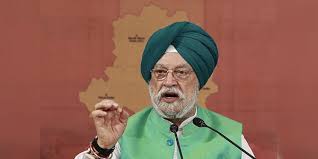Need Delhi, July 29, 2025: India is witnessing a renewed push in oil and gas exploration, particularly in offshore regions, as part of its strategic drive to tap into the country’s vast untapped hydrocarbon reserves. Addressing the Rajya Sabha on Tuesday, Petroleum Minister Hardeep Singh Puri highlighted the significance of unlocking nearly one million square kilometres of erstwhile ‘No-Go’ offshore areas in 2022, a move he described as a turning point in the nation’s energy sector.
The opening of these offshore regions, especially deepwater zones like the Andaman-Nicobar (AN) basin, has spurred a new wave of exploration activity. Since 2015, Exploration and Production (E&P) companies operating in India have made 172 hydrocarbon discoveries, of which 62 are in offshore territories. The Minister emphasised the geological richness of the Andaman-Nicobar basin, part of the Bengal-Arakan sedimentary system, which lies at the tectonic boundary between the Indian and Burmese plates. This area is believed to host numerous stratigraphic traps conducive to hydrocarbon accumulation, a belief bolstered by its proximity to proven petroleum systems in Myanmar and North Sumatra.
Recent major gas discoveries in South Andaman offshore Indonesia have further underlined the basin’s potential, attracting significant global attention and exploration interest. Puri credited this resurgence to strategic government interventions and a revised exploration framework that has enabled aggressive seismic data acquisition and exploratory drilling. He noted that several international partners have shown keen interest in the newly accessible frontier blocks.
National oil companies, including ONGC and Oil India Ltd (OIL), have embarked on an ambitious exploration campaign in the region. Four offshore stratigraphic wells are currently planned, including one in the AN basin. These wells are scientifically designed to validate geological models and assess the viability of petroleum systems, laying the groundwork for future commercial exploration.
For the first time, drilling in the Andaman ultra-deepwater region is targeting depths of up to 5,000 metres. ONGC has already reported hydrocarbon discoveries in 20 blocks with an estimated reserve of 75 million metric tonnes of oil equivalent (MMTOE). OIL has made seven discoveries over the past four years, comprising 9.8 million barrels of oil and 2,706.3 million standard cubic metres of gas.
Referencing the 2017 Hydrocarbon Resource Assessment Study, which estimated the AN basin’s potential at 371 MMTOE, the Minister informed the House that a 2D broadband seismic survey covering 80,000 Line Kilometres (LKM) of India’s Exclusive Economic Zone including the AN offshore area was completed in 2024. Additionally, OIL collected 22,555 LKM of 2D seismic data during the 2021–22 Deep Andaman Offshore Survey. These datasets have revealed promising geological structures, which are currently being validated through ongoing drilling operations by ONGC and OIL.
The developments mark a major stride in India’s efforts toward energy self-sufficiency and knowledge-driven exploration, setting the stage for a more robust and diversified hydrocarbon portfolio.

